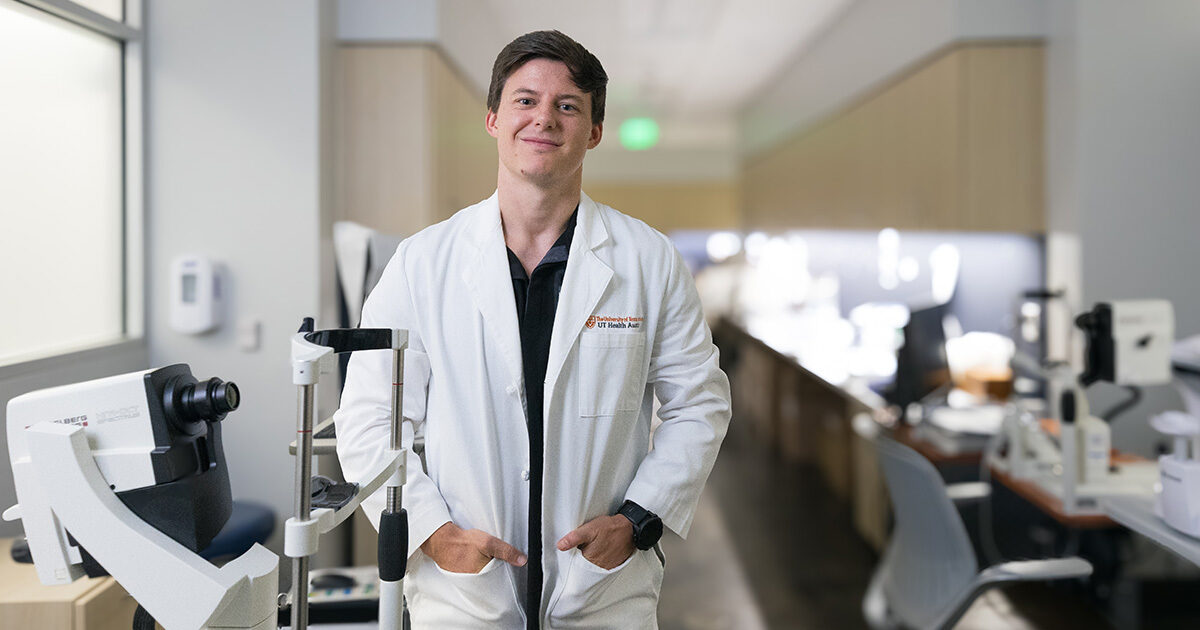Seeing Patients, Shaping Practice: Ophthalmology Residents at Work
How Dell Medical School and UT Health Austin are expanding access to eye care while training the next generation of specialists
Reviewed by: Gene Kim, MD; Kirby Taylor, MD
Written by: Lily Vining

A New Vision for Eye Care in Central Texas
In 2022, Dell Medical School welcomed its first class of ophthalmology residents — a milestone that launched a new training program and expanded access to high-quality eye care across Central Texas.
“We saw an opportunity to bring a new level of care to the community,” says Gene Kim, MD, board-certified ophthalmologist in UT Health Austin’s Mitchel and Shannon Wong Eye Institute and program director for the residency. “Before this program, there wasn’t a model like this, where residents were fully embedded in clinical operations from the start, in the region. Now, we have 12 residents across four classes and a team that sees over 8,000 patient visits a year, many of which would otherwise face significant delays or go unseen entirely.”
Learning by Leading
From day one, Dell Med’s ophthalmology residents are treated as integral members of the care team. Working alongside seasoned faculty across diverse clinical settings, they gain hands-on experience while helping the system function at its best. This structure, intentionally designed without separating learners from clinicians, allows residents to be learners, provide great care, and benefit the clinical practice simultaneously. Integrated into the daily rhythm of the clinic, residents take up to 70% of patient calls and are entrusted with real responsibility from the beginning. Their involvement ensures that a provider is always available for emergencies, often offering same-day access.
“It’s unheard of in medicine to be able to see any emergency at any time,” Dr. Kim explains. “But we can do it.”
A Chance to Build Something New
For fourth-year resident Kirby Taylor, MD, the program’s immersive structure and continuity-based approach, where each trainee follows their own panel of patients over time, has shaped not only his clinical skills, but also his approach to relationship-building with patients. When considering residency programs, the opportunity to help shape something new and meaningful drew him to Dell Med’s inaugural class.
“It was a bit of a gamble,” he admits. “But I had a gut feeling that leadership here was building something innovative and different.”
He recalls a 72-year-old woman with advanced diabetic eye disease, a condition that caused abnormal blood vessels to grow in her retina. Left untreated, it can quickly lead to bleeding, scarring, and permanent blindness. Her care required regular injections into the eye and multiple laser treatments — frequent, sometimes intimidating procedures that meant many visits to the clinic.
“At first, she wasn’t happy to be coming in,” Dr. Taylor says. “But over time, she slowly opened up. One day, she told me, ‘I’m so grateful for you for protecting my eyes.’”
For Dr. Taylor, that moment underscored the impact of building trust through continuity and compassion.
“For patients like her, preserving vision requires a ton of touchpoints,” he says. “Trust is built through those consistent interactions. That’s when the magic happens.”
Technology That Enhances Care
Another hallmark of the program is its embrace of cutting-edge technology — an essential component in preparing the next generation of ophthalmologists. Dell Med residents train with the latest tools, from high-resolution imaging systems and advanced diagnostic microscopes to light-adjustable lenses that can be fine-tuned after cataract surgery to deliver personalized vision correction. Being embedded in a Tier 1 research university in the heart of a tech hub also creates opportunities few other programs can match. Residents collaborate with experts across disciplines, including recent work with University of Texas professor Dr. Ilyas Iyoob and program director Dr. Kim on using artificial intelligence in medical education.
“It’s exciting to train in an environment where ophthalmology intersects with innovation and broader conversations in health care and technology,” says resident Jared Moon, MD.
That spirit of innovation extends to residents’ own ideas. With program support, Dr. Taylor is studying whether guided breathwork and mindfulness can reduce intraocular pressure and slow glaucoma progression.
“If you have an idea or vision, Dell Med will support you in it,” he says.
Training Leaders, Not Just Clinicians
At its core, the program aims to develop not just skilled clinicians, but future leaders ready to expand access to health care locally and globally.
“We don’t want to put top students in a box,” says Dr. Kim. “We want to grow leaders who will carry the UT name forward, move the needle in health care, and serve the patients who need them most.”
As the ophthalmology residency continues to grow, one thing is clear: The patients of Central Texas aren’t the only ones seeing a brighter future — so are the physician leaders shaping it.